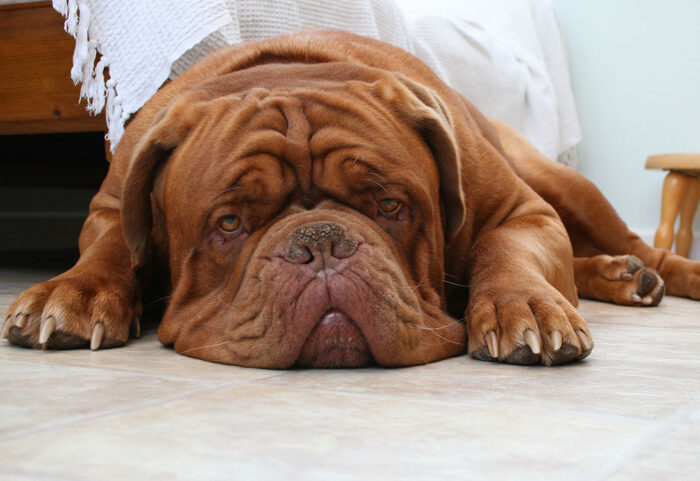5 Common Rhodesian Ridgeback Health Concerns
Rhodesian Ridgebacks are intelligent, confident, and athletic dogs with a strong sense of independence. Bred initially in southern Africa to assist hunters, these dogs are loyal protectors and affectionate family companions.
While generally healthy, Ridgebacks are prone to a few inherited and lifestyle-related conditions. Knowing what to watch for and how to manage it can help your dog live a longer, more comfortable life.

1. Hypothyroidism
Hypothyroidism happens when the thyroid gland doesn’t produce enough thyroid hormone (T4), which regulates metabolism, temperature, and energy levels. It’s one of the most common endocrine disorders in dogs, especially in medium- and large-breed dogs like the Rhodesian Ridgeback.
Thyroid hormones affect almost every organ system. When they’re low, metabolism slows down, leading to both physical and behavioral changes.
Common symptoms:
- Unexplained weight gain despite normal food intake
- Lethargy or fatigue—a dog who sleeps more and plays less
- Dry, flaky skin or hair loss, especially on the tail and flanks
- Cold intolerance (seeking warmth or shivering easily)
- Slowed heart rate or general weakness
- Possible changes in mood or increased irritability
A veterinarian can diagnose hypothyroidism by measuring T4 and TSH levels in bloodwork. Treatment involves a daily thyroid hormone supplement (levothyroxine), usually for life. It’s safe, affordable, and highly effective. Most dogs show improvement in energy and coat quality within weeks.
There’s no true prevention, but early detection through annual wellness exams helps. Keep a log of changes in appetite, weight, or energy, and discuss them with your vet.
2. Hip Dysplasia
Hip dysplasia is a developmental joint disease that occurs when the ball of the femur doesn’t fit properly into the hip socket. Over time, this misalignment causes friction, leading to pain, inflammation, and arthritis.
The condition can develop gradually, sometimes starting during puppyhood. Early detection and management help prevent severe pain later in life.
Signs of hip dysplasia:
- Limping or stiffness after exercise
- Difficulty standing up, climbing stairs, or jumping into the car
- “Bunny hopping” gait (both back legs moving together)
- Reluctance to run or play
- Muscle loss in the hindquarters
Treatment options:
- Maintaining a healthy weight helps reduce stress on your dog’s joints.
- Glucosamine, chondroitin, and omega-3 fatty acids can support joint health and mobility.
- NSAIDs or other anti-inflammatory medications prescribed by your vet can relieve discomfort.
- Swimming, underwater treadmill sessions, or laser therapy can improve joint flexibility and strength.
- In severe cases, procedures like total hip replacement or femoral head ostectomy may be needed.
It’s also important to feed a balanced diet and avoid over-exercising puppies, as too much jumping or running can strain developing joints. Regular veterinary exams, including X-rays when advised, can help detect issues early and keep your dog healthy.
3. Deafness
Deafness in Rhodesian Ridgebacks can be hereditary or age-related. Congenital deafness often appears in puppies and is caused by a lack of pigment cells (melanocytes) in the inner ear, which are needed for hearing.
Recognizing deafness:
- A puppy that doesn’t respond to loud noises
- Sleeping through disturbances
- Difficulty locating the source of sound
- Ignoring commands unless they can see you
Your vet can perform a BAER (Brainstem Auditory Evoked Response) test to confirm hearing loss.
Hearing-impaired dogs adapt well to structure and training. They rely heavily on body language, routines, and vibrations. Use:
- Hand signals for commands
- Vibration collars (not shocks) for attention outdoors
- Visual cues like lights or gestures
- Keep your dog leashed when outside and avoid startling them from behind
While you can’t prevent hereditary deafness, choosing a responsible breeder who screens puppies helps reduce risk. Protect hearing in older dogs by managing chronic ear infections promptly
4. Cataracts
Cataracts occur when the normally clear lens of the eye becomes cloudy, blocking light and causing partial or full vision loss. Cataracts may be inherited, age-related, or linked to diabetes.
Symptoms to watch for:
- Cloudy, bluish, or milky eyes
- Bumping into objects or hesitation in dim light
- Increased clumsiness
- Reluctance to jump or move confidently
- Changes in pupil appearance
Treatment depends on severity:
- Early-stage: Regular monitoring and antioxidant supplements may slow progression.
- Advanced cases: Cataract surgery (phacoemulsification) can often restore vision.
With treatment, most dogs regain near-normal eyesight. Those who don’t undergo surgery usually adapt well using smell and hearing to navigate.
There’s no guaranteed prevention, but annual eye exams can detect cataracts early. Feeding antioxidant-rich foods and managing diabetes can lower risk.
5. Dermoid Sinus
A dermoid sinus is a congenital defect most often seen in Rhodesian Ridgebacks. During embryonic development, a small tract or “sinus” forms under the skin along the spine or neck when the skin and spinal cord don’t entirely separate. The sinus may look like a small dimple, bump, or narrow opening on the skin’s surface. It can be shallow or deep, and sometimes connects to the spinal canal.
Hair, oil, and debris can become trapped, leading to inflammation, infection, or abscess formation. In severe cases, it can cause neurological issues if it reaches deeper tissues.
Once removed, dogs live normal, healthy lives. Reputable breeders routinely check puppies before adoption to minimize risk in future generations.
Rhodesian Ridgebacks are strong, intelligent, and deeply loyal dogs. While they’re generally a healthy breed, being aware of their most common health risks helps you stay one step ahead. With attentive care, Rhodesian Ridgebacks can live 10–12 years, and many enjoy healthy senior years—exactly what every devoted dog deserves.
Join Our Pet Health Community
Dog owners and pet parents like you are shaping the future of veterinary care. Be the first to hear about regenerative medicine, clinical research, and tips for keeping your animals thriving.


